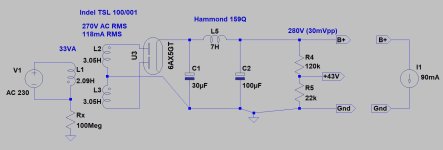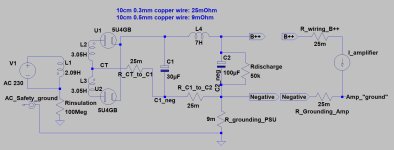I did a fair amount of research and reading about grounding and hope I have it right.
However, this is my first build and I’ve likely made mistakes. I’m a little confused about the grounding of the PS first capacitor… used motor run caps
Suggestions please:

However, this is my first build and I’ve likely made mistakes. I’m a little confused about the grounding of the PS first capacitor… used motor run caps
Suggestions please:
Rob7,
Correct.
The first [hum] ground loop is power transformer secondary, rectifier, first capacitor.
With a wire from the negative of the first filter cap connected to the secondary center tap . . .
The largest current transients are contained in the shortest loop possible:
secondary wire 1, to rectifier, to first cap positive; then the first filter cap negative, to the center tap.
secondary wire 2, to rectifier, to first cap positive; then the first filter cap negative, to the center tap.
From the positive terminal of the first filter cap, that goes to either a resistor or a choke, to the positive of the second filter cap.
The negative of the first filter cap is then connected by a wire to the negative of the second filter cap.
The first ground loop is purposely local to the secondary, rectifier, first filter cap (all the transient current is in that local loop.
After that local loop has been established, then you connect from cap 1 negative to cap 2 negative.
Next, you connect yet another wire from cap 2 negative to the central ground.
My amplifiers do not use global or Schade negative feedback.
Even so, their hum is less than 100uV at the output terminals (0.1mV).
Correct.
The first [hum] ground loop is power transformer secondary, rectifier, first capacitor.
With a wire from the negative of the first filter cap connected to the secondary center tap . . .
The largest current transients are contained in the shortest loop possible:
secondary wire 1, to rectifier, to first cap positive; then the first filter cap negative, to the center tap.
secondary wire 2, to rectifier, to first cap positive; then the first filter cap negative, to the center tap.
From the positive terminal of the first filter cap, that goes to either a resistor or a choke, to the positive of the second filter cap.
The negative of the first filter cap is then connected by a wire to the negative of the second filter cap.
The first ground loop is purposely local to the secondary, rectifier, first filter cap (all the transient current is in that local loop.
After that local loop has been established, then you connect from cap 1 negative to cap 2 negative.
Next, you connect yet another wire from cap 2 negative to the central ground.
My amplifiers do not use global or Schade negative feedback.
Even so, their hum is less than 100uV at the output terminals (0.1mV).
In the bottom left of your pic, are all your PSU zero volt wires attached to the chassis?
Use a 10R to 100R resistor and a 0.1 to 0.22 or so cap, maybe also a rectifier bridge as a ground lift.
Use a 10R to 100R resistor and a 0.1 to 0.22 or so cap, maybe also a rectifier bridge as a ground lift.
"Ground Lifts"
OK, if you insist on doing that.
(I Never use Ground Lift circuits, and my amplifiers have less than 100uV hum and noise [less than 0.1 mV hum and noise]).
Just do Not use a 3 Amp slow blow fuse to power the transformer primary . . .
And then use Wimpy 10 Ohm or 100 Ohm resistors, and Wimpy 1 Amp diode(s)!
Wimpy = Weak Link.
If there is a short in the amplifier, the weakest Link will open up (Wimpy Ground Lift circuits).
By the way, if there is AC or Signal across the diodes, it will clip that Ac or signal, create transients, and high frequency noise.
Safety First!
Prevent the "Surviving Spouse Syndrome"
I remember when we were testing an output transformer. There was a short from the primary to the laminations and end bells. Ouch!
OK, if you insist on doing that.
(I Never use Ground Lift circuits, and my amplifiers have less than 100uV hum and noise [less than 0.1 mV hum and noise]).
Just do Not use a 3 Amp slow blow fuse to power the transformer primary . . .
And then use Wimpy 10 Ohm or 100 Ohm resistors, and Wimpy 1 Amp diode(s)!
Wimpy = Weak Link.
If there is a short in the amplifier, the weakest Link will open up (Wimpy Ground Lift circuits).
By the way, if there is AC or Signal across the diodes, it will clip that Ac or signal, create transients, and high frequency noise.
Safety First!
Prevent the "Surviving Spouse Syndrome"
I remember when we were testing an output transformer. There was a short from the primary to the laminations and end bells. Ouch!
Had to read that a couple of times!Correct
just to make sure we’re on the same page. Didn’t quite follow your description connecting C1 to Rectifier:
“secondary wire 1, to rectifier, to first cap positive……secondary wire 2, to rectifier, to first cap positive….” maybe I’m being too too literal but it seems this would short the secondaries?
This amp uses a 6AX5GT rectifier tube. There is no connection between the heaters and cathode. Heater on pins 2 and 7. Cathode is pin 8. maybe that’s where the confusion lies?
that said, it seems I have followed most of your advice and merely need to connect C1 negative to C2 negative? (green line in photo). But wouldn’t that create a ground loop?
Last edited:
But they are connected already: C1 negative goes to the PT center tap…to the star ground…to C2 negative. As highlighted in yellow.required for operation.
If I put the green wire in as depicted, there will be two connections between C1 negative and C2 negative… isn’t that a groundloop?
I’m sure I’m making this way too difficult, but somehow I am just not getting this.
should I add the “green wire“, as drawn, and remove the wire between the center tap to the star ground?????
Last edited:
What is the "brownish" wire attached to negative of C1 going to? I typically use a bus bar grounding system. That would be a bare wire where your green connection is and my grounds get soldered to that. Not saying I'm doing things correctly. I'm interested in the star ground scheme.
The negative of the first filter cap is then connected by a wire to the negative of the second filter cap.
The first ground loop is purposely local to the secondary, rectifier, first filter cap (all the transient current is in that local loop.
After that local loop has been established, then you connect from cap 1 negative to cap 2 negative.
Next, you connect yet another wire from cap 2 negative to the central ground
Like This?
Like This?
View attachment 1313652
Better. I still feel your gnd wiring is way too long and prone noise pickup. I would move the star gnd close to the center of the chassis.
I don't like Stephe's way AT ALL as it carries the hum from the CT and the first cap to the star point. Bad mojo.
If that is "bad mojo", why are all my amps built like this quiet? But doesn't shock me, anything I post of this forum is TRASHED, not sure why I even bother replying here anymore.
Note in this article, they don't show in their star ground examples the cap grounds being all daisy chained across the amp before going to the star ground point. https://www.valvewizard.co.uk/Grounding.pdf
Note in this article, they don't show in their star ground examples the cap grounds being all daisy chained across the amp before going to the star ground point. https://www.valvewizard.co.uk/Grounding.pdf
Last edited:
Thanks for the input Stephe. You are responsible for this amp…my first. Without your inspiration and videos I would’ve never built it!Remove that one wire from the CT to that one cap negative, and then hook the negative of that cap
As to this grounding scheme, I am absolutely open to any and all ideas. I kind of enjoy the fine art of hair splitting sometimes!
That is a concern of mine. However, I did everything I could to tuck the wires away from all sources of noise. I grounded it as is in an attempt to keep the ground wires away from the nasty 120 hz ripple in the wire from the rectifier to the choke. The ground wires and the choke wire are kind of “S”d away from each other intentionally. I chose a little extra length for greater separation and tucking the wires into the corner of the chassis. Good idea or not… Still learning. I was also thinking, one way or another the grounds all had to reach the center tap… Be it multiple wires or a single wire—total distance and length would be the same regardless of the positioning of the star ground. Again, maybe flawed thinking…just an insight into my thought process. Thanks for your input. That’s exactly why I posted here. A conglomerate of ideas from a highly experienced group.gnd wiring is way too long and prone noise pickup
Last edited:
A little bump. Again, not totally clear on your original post. Did I get it right with my photo in post number 12?Correct
I know the answer must be so simple, yet it escapes me. My apologies, but…I’m a visual learner.
One more go at this:
option 1 (blue)
option 2 (green)
or none of the above…. (If I get this resolved, then I will move onto the positive side of C1. Only one other option that I can see)

One more go at this:
option 1 (blue)
option 2 (green)
or none of the above…. (If I get this resolved, then I will move onto the positive side of C1. Only one other option that I can see)
Last edited:
- Home
- Amplifiers
- Tubes / Valves
- 45 tube amp grounding critique (with photo)

